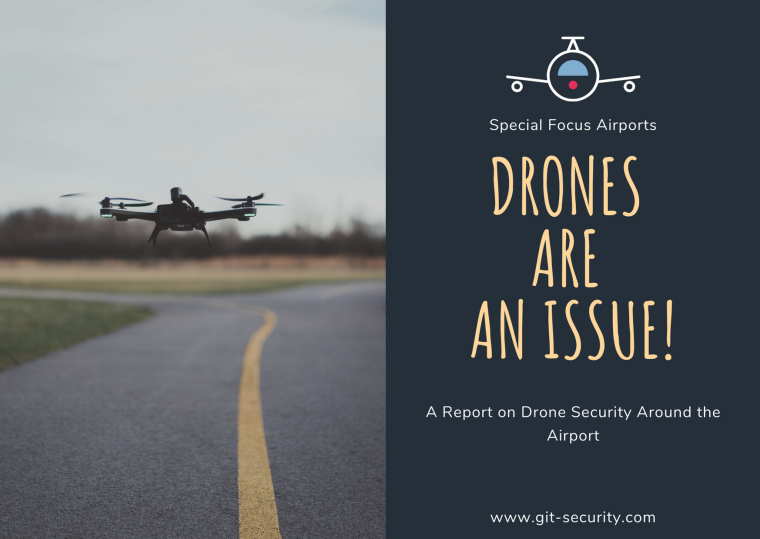Special Focus Airports: Drones Are An Issue

GIT SECURITY takes on the topic of drones to talk about the latest incidents, regulatory situation and about many questions that come up around the topic of drones. Let’s take a look around an airport!
One of the most crucial parts of any airport is the runway. Not only are starting and landing supposedly the most attention-seeking times for captain and crew, even the smallest disruptions like birds or anything on the runway can cause lots of damage or an immediate call-for-action. This leads to distress not only with the crew, but also for the passengers.
Drone Incidents at Airports
Time and again, the media reports on drone incidents that are causing air traffic to be disrupted. The number of drones, especially in private use is rising and with that, so do drone incidents at airports all around the world. For example, many flights were diverted from Dubai International Airport in 2019 due to suspected drone activity. Maybe one of the heaviest impacts of drone activity in 2019 happened at Gatwick Airport, when approximately 140,000 passengers and over 1,000 flights were affected. The Guardian then wrote “Heathrow and Gatwick invest millions in anti-drone technology”. In February 2020, many newspapers reported on a disruption at a Madrid Airport caused by drone sightings. For over one hour, flights to and from Adolfo Suárez-Barajas airport were disrupted and the airspace around the airport had to be closed. In March 2020 – a similar scenario at the Frankfurt Airport: According to Frankfurter Allgemeine Zeitung, air traffic had to be suspended for 90 minutes. Drones are an issue and the numbers rise with every month.
Drone Detection
Drones represent a very large safety risk in many respects: They are very small, so they are often discovered very late or only with the naked eye as conventional radar systems often fail to detect them. The area around the airport is always a restricted area. Nevertheless, drone owners manage to penetrate these areas again and again. It often takes a long time from drone detection to alarm and localization. Entering such areas is not only a security risk, but also a criminal offence, which is why the police are also notified of such incidents. They have to patrol the extensive area around the airport to locate the drone and its owner. If a police helicopter is on duty, it must also follow the flight zones. Thus, from a drone sighting to an arrest is a troublesome process.
What Can Security Systems Currently Do?
Security systems at airports often consist of multiple layers of security. Drones fly with radio frequency, which sends signals about location, battery etc. to the station. These radio frequencies can be received and analyzed by sensor manufacturers. With an intelligent analysis behind the sensors, it is now even possible to differentiate between different models of drones. This happens at a range of about 1-2 kilometers. In case of an alarm, the surveillance cameras are used to provide video evidence. In some cases, it is even possible to send interfering signals to the drone, which triggers the drone’s home function to force it to land safely. One can imagine that in an area as large as an airport, 1-2 kilometers covers a big distance, but is not enough to secure it all the way. If you consider that landing strips have a length of around 1.5 kilometres and upwards, and considering that aircraft fly with high speed, you soon realise that the drone defence system still needs to be upgraded considerably in terms of safety.
The Legal Situation
The topic of drones is overshadowed by a large grey cloud of ambiguity, because the legal situations in countries across the world differ greatly. In June 2019, there was an overarching decision by the EU that defines the use of drones for their owners, but there are still large gaps and question marks in the legislation. For example, in the defense against drones. What happens if a drone that is in a high-risk zone is taken out of the air? Shooting down a drone proves to be much more difficult than initially assumed. The shot may miss, parts of the drone may splinter off, and then the drone has to be brought to the ground, which also poses a safety risk. So far, the regulations for unmanned aircraft vehicles are not yet fully developed.
Another problem arises when thinking about regulations concerning manned aircraft. Whether and how manned aircraft may and should evade drones is always accompanied by the question of extreme safety and is therefore too complex for a simple solution to be effective. So, it is probably easier to clarify the legal situation on the drone side. However, a great deal of research is still needed.
Impact Tests
Questions about the impact of a drone collision with an aircraft are dealt with by the University of Dayton. A team of researchers has been investigating the impact of birds on aircraft parts for over 40 years. Since drones are very similar in weight and size to birds, they are currently testing how the situations develop in drone collisions. In one experiment, the researchers compared the impact of a gel bird and a drone on a wing selected to represent a leading edge structure of a commercial transport aircraft. They came to the following conclusion: “The bird did more apparent damage to the leading edge of the wing, but the Phantom penetrated deeper into the wing and damaged the main spar, which the bird did not do,” said Kevin Poormon, group leader for impact physics at UDRI. Another consideration regarding the regulations falls onto the production of drones. It may already help to make the drones more fragile so that they break more quickly on impact. A weight limit can also help. In logistics, there are already efforts to use drones for parcel deliveries. If drones were to perform such tasks, they would increase in size and weight. This also increases the security risk enormously. Tests with bird types comparable to the Canada Goose have already reported tremendous damage to aircraft parts. The “post drones” would far exceed the weight of a Canada Goose.
Perhaps with the maturing of artificial intelligence in video surveillance systems, it will soon be possible to distinguish between the flight of birds and the flight of drones - be it through sophisticated thermal image analysis or the recognition of wing beat movements or typical flight patterns of birds and drones. The development and use of drones is an extremely dynamic process. Politicians, as well as researchers and developers of security systems, have to keep pace to ensure highest possible security standards, especially at airports.














